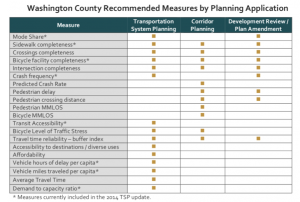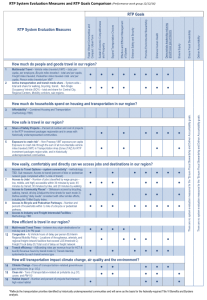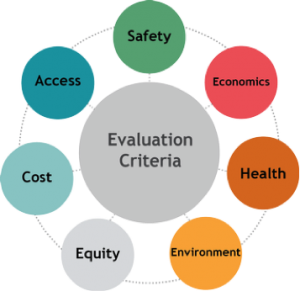
Trickle-up performance measures
While working to enhance its performance-based planning framework, Metro, the metropolitan planning organization for the Portland, Oregon region, can draw from the experience of local jurisdictions within its own region — bringing unanticipated benefits through “trickle-up” learning.
This is the second of a series of posts on the issues and challenges of performance-based planning in the Portland region.
When Metro kicked off the process of developing its long-range transportation plan governing the next ten years of spending it was clear that performance measures would be a focus, both because of the new requirements created by the 2012 federal transportation law (MAP-21) and a growing public interest in making smarter choices about transportation investments.
Metro convened a workgroup of stakeholders to provide guidance on performance measures. To get things started, Metro hosted a workshop in January of 2016, which included presentations on the performance measure work of two local jurisdictions: City of Portland and Washington County.
The experience of each of these jurisdictions offered up lessons that have informed the workgroup’s efforts to identify performance measures and develop a framework to inform Metro’s next long-range plan.
As part of its transportation plan, Portland has used performance-based criteria as a way to prioritize investment, and has been careful to ensure that those criteria reflect the city’s values. Criteria were derived from numerous sources that incorporate citizen input. The seven criteria are “cross-modal”; they evaluate various concerns and support a balance among modes.
In 2014, Washington County published Multimodal Performance Measures and Standards, prepared by Kittleson & Associates. The report strives to identify performance measures that are relevant to non-automobile modes of travel. While the suite of performance measures identified in this study are useful fodder for Metro’s workgroup, some of the greatest value is the lessons learned in the process, and the opportunity to adapt some of the study’s approaches to evaluating the performance measures themselves.
While the study lists five lessons learned, the first two are most of interest:
- Different measures are best for different planning applications.
- Different measures may be needed to assess the same goal.
These two lessons, along with the use of matrices to visually compare proposed measures, are playing the biggest role in informing the work of Metro’s performance measures workgroup.

Washington County, Oregon developed matrices to identify how proposed performance measures could be applied.
Taken together, these lessons led the workgroup to ask for matrices to illustrate the role of performance measures under consideration for Metro’s long-range plan. Metro is using two types of matrices to answer two questions. First, what is the relationship between the proposed performance measures and the region’s goals. Second, at what stage of planning can each performance measure be applied?
For example, Metro is using vehicle miles traveled as a performance measure in several stages of planning. It’s important to understand how this measure relates to several of the regions’ goals including efficiency of the transportation system, reducing household transportation costs, reducing greenhouse gas emissions and improving safety. A matrix comparing proposed measures with the region’s goals helps workgroup members to visualize those relationships and identify redundant measures.

Metro staff developed a matrix that communicates how each proposed performance measure addresses the region’s goals.
Likewise developing a matrix to look at how measures can be applied is also helpful. For example, crash rate is something that cannot be predicted in Metro’s travel model. So while safety is a major goal for most transportation agencies, a proxy may be needed to inform selection of a preferred scenario or project prioritization. Metro is considering a measure they are calling “VMT exposure” which is the amount of traffic on surface streets. While this isn’t an exact measure of safety by any means, it is strongly correlated and can be easily forecast in a transportation model. Crash rate will be used as a monitoring measure to determine if the region’s investment strategy is working to reduce crashes in hindsight.
Besides the ideas on how to evaluate performance measures, there is an additional benefit to learning from local jurisdictions: consistency between local measures and regional measures. Getting everyone on the same page to coordinate regional investments helps ensure that all dollars are going to accomplish goals that are shared across the region. Regional performance measures that reflect those bubbling up from local jurisdictions will help local jurisdictions like Portland and Washington County that are already ahead of the game develop local plans that reflect their own local values while still being consistent with the regional plan.




